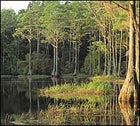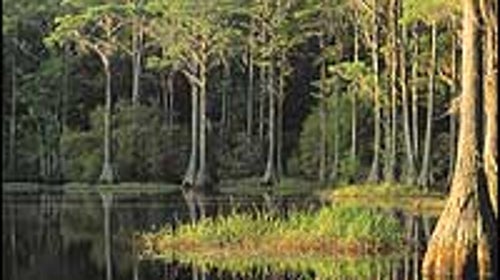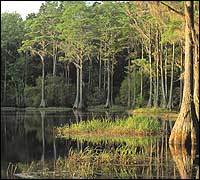Utterly unlike a dip into a chlorinated cement pond, that first plunge in a swimming hole is an initiation into the soul of summer. There’s the thrilling sensation of a river’s current, the electrifying possibility of brushing up against something green and furry or of drifting smack into a school of fish.

The perfect swimming hole, whether it’s fed by river or hot spring, should present something of a challenge—getting there should involve amphibious hiking, some light bouldering, a bit of bushwhacking—to work up the necessary preswim sweat. A worthy sink is also secluded, with a few key physical attributes: cliffs for cannonballs, a waterfall for background music, scum-free water, maybe a wedge of sandy beach. Here I’ve solicited personal favorites from friends of the magazine. Add them to your own list. Pack the kids in the car. Leave the mountain bikes, the ropes and carabiners, the kayaks and mega-packs in the garage, and savor the simple joy of a swim in the woods.
ARKANSAS
Unlike rapid-choked rivers in the West, the Buffalo National River is very much a lollygagging, langourous river—perfect for family canoeing—that flows for 150 miles beneath natural arches and towering limestone bluffs, past caves and box canyons, and over a 175-foot waterfall. There are hundreds of swimming holes along the way—clear, deep pools fed by underground springs, some accessible only by canoe or inner tube. But there’s a particularly stunning little bend at the Steel Creek primitive campground. Shallow and warm enough for little kids, Steel Creek sports a sloping gravel beach facing a glorious fern fall where maidenhairs cascade down a hundred-foot bluff—the centerpiece of the longest canyon in the Ozarks.
Getting there: From Arkansas 7 take Arkansas 74 west for 11 miles. Turn right at the Steel Creek Campground sign. Hike down and splash in.
CALIFORNIA
Along Yosemite’s Chilnualna Falls Trail (near Wawona) lie a series of smooth, granite-walled swimming bowls that look as if they were shaped by a potter’s hands. The first features thoughtfully placed underwater ledges but requires some scrambling to get to. The second is a primo spot even for preschoolers. You’ll likely have this transcendent hole to yourselves, since it’s not visible from the trail. Here, enormous sculpted boulders resembling water-filled dinosaur bones offer diving ledges and graduated basins. Bring insect repellent—stagnant pools just above the second bowl grow ferocious mosquitoes. And be careful: the granite can be slick, making the tubs hard to get in and out of, and spring runoff makes for swift-moving water.
Getting there: Hike a mile in from the Chilnualna Falls trailhead. Where the switchbacks take a wide turn to the left, peel off right toward Chilnualna Creek, and follow it a quarter-mile upstream.
FLORIDA
You have to take a boat or canoe to get to Rock Bluff Spring, since the land around it is privately owned. Once you get there, you’ll discover a shallow sink—only about three feet deep and perfect for little ones—except for a four-foot-wide fissure that leads to an underwater cave. And towering above the pool is a huge cypress with broad wooden steps nailed in. People are rumored to have dived from the rafters of that cypress—60 feet up—down into the pinched mouth of the crack, but don’t give your kids any ideas.
Minus the daredevils, Rock Bluff Spring is a sultry Southern hole where you can wade in the clear shallow water, swim down that crack into the aquifer, or nap the afternoon away.
Getting there: It’s about a half-mile paddle north of the Gilchris County Highway 340 bridge that crosses over the Suwannee River just outside Gainesville.
IDAHO
The hike in to Jerry Johnson Hot Springs is short and zoological. An entire herd of elk may lumber across the trail. Rubbernecking moose often stand saucer-eyed, dumbstruck by a troop of humans charging past. Got to love what the humans have done with the place, though, arranging boulders into cozy tubs positioned just so, to produce a warm blend of Jerry Johnson-hot and mountain creek-cold water. Better go during the day, as, like many hot springs, it may get R-rated after dark. If you’re headed toward Missoula on scenic U.S. 12, one JJ zealot insists that Guy’s Lolo Creek Steakhouse, where they serve fat T-bones and huckleberry daiquiris (virgins for the kiddos), is the perfect end to a supremely OK day.
Getting there: Look for Warm Springs Park, 20 miles west of the Montana border on U.S. 12. There’s a bridge with a trailhead beside it on the left. The first set of pools is a mile’s hike down the trail. Continue another 30 yards to find still more hot-springs pools.
UTAH
The less-than-inspired Mormon-given name (ever read a street map of Salt Lake City?) Fifth Water Hot Springs belies the magic of this warm-water playground. Cool waterfalls spill into family-size pools fed by hot springs. At the moment, the only easy way to reach the springs is from the north, along Fifth Water Creek. (In 2003, when road construction is finished, the preferred route will once again be the scenic and uncharacteristically lush approach from the south, along the higher-volume Sixth Water Creek.) Either way you go, the springs are well worth the trek. Bring an extra pair of sneakers for the kids to wade in, since the rocks can be sharp and slippery.
Getting there: About 23 miles southeast of Spanish Fork on U.S. 6, take a left onto Sheep Creek Road. Drive another 15 miles to the Fifth Water Trailhead (pick up a map from the U.S. Forest Service office in Spanish Fork, as the sign is hard to see). It’s a four- to five-mile hike, round-trip.
VIRGINIA
Panther Falls, my own family’s all-time favorite swimmin’ hole, is an easy quarter-mile walk in along a shady creek. Heading downstream, you hit the falls at their spill-point, atop one side of a pair of 30-foot cliffs that guard the first of three fine potholes. The pièce de résistance on this Virginia masterpiece is the set of mossy granite slides that connect the three pools—gentle enough for a five-year-old to take on. Sloping slabs provide a generous berth for warming up in the sun and front-row seats for watching the trout climb the falls.
Getting there: Get off the Blue Ridge Parkway at U.S. 60, heading east (away from Buena Vista). Turn right at Panther Falls Road (Forest Service Road 315), where there’s a small sign for Panther Falls. The dirt road winds steeply downhill for about three miles. The first trailhead, leading to the top of the falls, is at a small parking area on the left. Another, larger parking lot, leading to the bottom of the falls, is also on the left, a little farther down the road.
WYOMING
One of Yellowstone’s secrets is a stretch of the Gardner River about a half-mile from the main road. Hot water from the Boiling River spills over the banks of the Gardner into several sheltered pools offering varying degrees of heat, right up to hot-as-you-can-stand-it. Once you’re quite parboiled, wade toward the far side of the river—the bracing snowmelt is a quick cool-down. Small cascades of hot (130 degree) water heat these shallow pools, making them a favorite of families with young children.
Because the river is in the northern section of the park, the high-desert landscape allows unobstructed views of the Gallatin Range to the west and the Absaroka peaks to the north and east. One caveat: The pools only become accessible in mid-June, when the water levels drop enough to reveal them.
Getting there: Head north for two miles from Mammoth. Pull off on the service road on the right (where there is a sign marking the 45th parallel of latitude), just before the bridge, and hike in about a half-mile.


